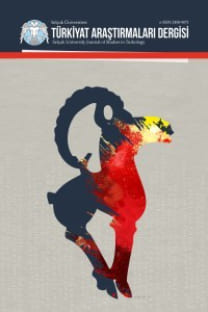TÜRKÇE İŞARET SÖZCÜKLERİNDE GÖNDERGENİN KONTROL EDİLEBİLİRLİĞİ ÜZERİNDEKİ BAZI KISITLAMALAR
SOME LIMITATIONS ON THE CONTROLLABILITY OF THE REFERENT IN TURKISH DEMONSTRATIVES
___
- BALPINAR, Metin (2011), ‚Torukogo shijishi no bunmyaku shiji yōhō ni tsuite: Bunshōōkei toshite no bu, o no yōhō‛ *On the the text dependent use of Turkish demonstratives: the usage of bu and o as sentence anaphor]. Kyōto Daigaku Gengogaku Kenkyū, 30: 71-105.
- BALPINAR, Metin (2012), ‚Torukogo shijishi ni okeru hibunmyaku shiji yōhō to bunmyaku shiji yōhō ni tsuite: bunmyaku shiji yōhō wo chūshin ni‛ *On non-text and text dependent uses of Turkish demonstratives: focusing on text dependent use]. Ajia & Afurika Gengo Bunka Kenkyū, 83: 89-116.
- BALPINAR, Metin (2014), ‚Torukogo shijishi ni okeru hibunmyaku shiji yōhō no saikentō‛ *Re-examination of the non-text dependent use of Turkish demonstratives]. Tōkyō Daigaku Gengogaku Ronshū, 35: 21-39.
- BALPINAR, Metin (2019), Demonstratives and Grammaticalization: A Perspective from Modern Turkish, London and New York: Routledge.
- BANGUOĞLU, Tahsin (2004), Türkçe’nin Grameri, Ankara: Türk Dil Kurumu.
- BASTUJI, Jacqueline (1976), Les Relations Spatiales en Turc Contemporain; Étude Sémantique. Paris: Éditions Klincksieck.
- BAYDUR, Memet (2009), Tiyatro Oyunları, İstanbul: İletişim Yayınları.
- ERGİN, Muharrem (1958), Türk Dil Bilgisi, İstanbul: İstanbul Üniversitesi Edebiyat Fakültesi Yayınları.
- GENCAN, Tahir Nejat (2001), Dilbilgisi, Ankara: Türk Dil Kurumu.
- GÖKSEL, Aslı - KERSLAKE, Celia (2005), Turkish: A Comprehensive Grammar, London and New York: Routledge.
- HAYASI, Tōru (1985), ‚Torukogo no shijishi‛ *Turkish demonstratives]. Ajia & Afurika Gengo Bunka Kenkyūjo Tsūshin, 53: 55-57.
- HAYASI, Tōru (1989), ‚Torukogo no susume 3: ‘kore-sore-are’ are kore‛ *An invitation to Turkish 3: ‘kore, sore, are’ are kore+. Gengo, 18.1: 96-101.
- HAYASI, Tōru (2004), ‚Türkçe ve Japonca İşaret Sözcükleri Üzerine Bir Deneme‛. Dilbilim Araştırmaları, 2004: 51-62.
- HAYASI, Tōru (2008), ‚Torukogo shijishi şu no tokuchō‛ *Characteristics of the Turkish demonstrative şu]. Tōkyō Daigaku Gengogaku Ronshū, 27: 217-232.
- HAYASI, Tōru (2009), ‚Torukogo shijishi no sentaku ni okeru washa no handan no baratsuki‛ *How variant are the judgments of Turkish speakers on the usage of demonstratives?]. Tōkyō Daigaku Gengogaku Ronshū, 28: 267-282.
- HAYASI, Tōru (2014), ‚Temporal characteristic of the Turkish demonstrative şu,‛ Turcology and Linguistics: Éva Ágnes Csató Festschrift, Nurettin Demir, Birsel Karakoç, Astrid Menz (Eds.). Ankara: Hacettepe Üniversitesi: 209-218.
- IINUMA, Eizō. (1995), Torukogo Kiso *Basic Turkish+, Tōkyō: Besutosha.
- IRMAK, Coşkun (2002), Siyah Çoraplılar. İstanbul: Mitos Boyut Yayınları.
- JANSKY, Herbert (1943), Lehrbuch der Türkischen Sprache, Wiesbaden: Otto Harrassowitz.
- KINSUI, Satoshi – et al. (2002), ‚Shijigo no rekishiteki-taishō gengogakuteki kenkyū: Nihongo-Kankokugo- Torukogo‛ *Historical and comparative linguistic studies of demonstrative words: Japanese, Korean, Turkish], Shirīzu Gengo Kagaku 4 Taishō Gengogaku [Series in linguistic science 4 contrastive linguistics], Naoki Ogoshi (Ed.). Tōkyō: Tōkyō daigaku shuppankai: 217-247.
- KORKMAZ, Zeynep (2009), Türkiye Türkçesi Grameri: Şekil Bilgisi, Ankara: Türk Dil Kurumu.
- KORNFILT, Jaklin (1997), Turkish, London: Routledge.
- LEWIS, Geoffrey L. (1967), Turkish Grammar, Oxford: Oxford University Press.
- NISHIOKA, Izumi (2006), Gendai Churuku shogo no shijishi no kenkyū [A study on demonstratives in modern Turkic languages], Fukuoka-Japan: Kyūshū University (unpublished doctoral dissertation).
- ÖZYÜREK, Aslı (1998), ‚An analysis of the basic meaning of Turkish demonstratives in face-to-face conversational interaction,‛ Oralité et Géstualité: Communication multimodale, interaction, Serge Santi, Isabelle Guaïtella, Christian Cavé, Gabrielle Konopczynski (Eds.). Paris: L'Harmattan: 609-614.
- PETERS, Ludwig (1947), Grammatik der Türkischen Sprache, Berlin: Axel Juncker Verlag.
- SWIFT, Lloyd B. (1963), A Reference Grammar of Modern Turkish, Bloomington: Indiana University.
- UNDERHILL, Robert (1976), Turkish Grammar, Cambridge: The MIT Press.
- ISSN: 1300-5766
- Yayın Aralığı: 3
- Başlangıç: 1994
- Yayıncı: Selçuk Üniversitesi
YAŞAM İLE ÖLÜM ARASINDA: 17. YÜZYILIN SON ÇEYREĞİNDE KIRIM TOPLUMUNDA KÖLELER VE ŞİDDET
TÜRK MODA FOTOĞRAFÇILIĞININ TARİHSEL GELİŞİMİ
OSMANLI VE CUMHURİYET DÖNEMİ’NDE MADER-İ MEVLÂNA KÜLLİYESİ’NİN BAKIM VE ONARIM FAALİYETLERİ
TÜRKÇE İŞARET SÖZCÜKLERİNDE GÖNDERGENİN KONTROL EDİLEBİLİRLİĞİ ÜZERİNDEKİ BAZI KISITLAMALAR
İKİNCİ DÜNYA SAVAŞINDA TÜRK DIŞ POLİTİKASI: TARAFSIZLIK, DİPLOMASİ VE DEVLET YÖNETİM
